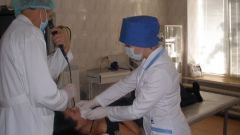If for some reason in the pleural cavity will accumulate the air pressure in the lungs will increase and its volume will decrease. Consequently, people will begin to experience chest pain, it would be difficult to breathe. In the most severe cases, possible death due to acute lack of oxygen. And why do the air can accumulate in the pleural cavity?
This phenomenon (the introduction of air into the pleural cavity) was known to doctors of Ancient Greece, which gave him the name of "pneumothorax", which is derived from the word "pneuma -" air "and" thorax" – the chest." Pneumothorax occurs either as a result of penetrating wounds of the chest, or as a consequence of certain chronic diseases of the lungs. But it can also develop as a complication of a chest injury or as a result of unsuccessful treatment of a chest.
Pneumothorax is of two types: indoor and outdoor (with penetrating wound of the chest). In the second case, the patient's condition can rapidly deteriorate in a short time, so as soon as possible to stop the access of air into the pleural cavity. To provide the victim of the qualified medical aid should be tightly closed the wound with airtight material and securely fix it on the body. As such material is suitable, for example, plastic film or oilcloth. You can use thick cotton-gauze bandage.
When pneumothorax noted severe pain in the chest, dry hacking cough, voice trembling. In some cases the pain may radiate to the shoulder and abdomen. On examination, the patient is marked pallor.
To provide expert assistance to the person (especially when severe pneumothorax) can only be a specialist, therefore the victim needs to be taken to a medical facility. The diagnosis is made as the results of inspection and complaints of the patient, and after x-ray of the chest cavity or computed tomography. If necessary, the air from the pleural cavity is evacuated using a special syringe, piercing the top layer of the pleura, or by installing a drainage tube.
If you have an open wound it is sewn up in a medical facility. In the most severe cases it is necessary to remove part of the damaged lung.
For some reason air can get into the pleural cavity
This phenomenon (the introduction of air into the pleural cavity) was known to doctors of Ancient Greece, which gave him the name of "pneumothorax", which is derived from the word "pneuma -" air "and" thorax" – the chest." Pneumothorax occurs either as a result of penetrating wounds of the chest, or as a consequence of certain chronic diseases of the lungs. But it can also develop as a complication of a chest injury or as a result of unsuccessful treatment of a chest.
Pneumothorax is of two types: indoor and outdoor (with penetrating wound of the chest). In the second case, the patient's condition can rapidly deteriorate in a short time, so as soon as possible to stop the access of air into the pleural cavity. To provide the victim of the qualified medical aid should be tightly closed the wound with airtight material and securely fix it on the body. As such material is suitable, for example, plastic film or oilcloth. You can use thick cotton-gauze bandage.
When pneumothorax noted severe pain in the chest, dry hacking cough, voice trembling. In some cases the pain may radiate to the shoulder and abdomen. On examination, the patient is marked pallor.
How to remove the air accumulated in the pleural cavity
To provide expert assistance to the person (especially when severe pneumothorax) can only be a specialist, therefore the victim needs to be taken to a medical facility. The diagnosis is made as the results of inspection and complaints of the patient, and after x-ray of the chest cavity or computed tomography. If necessary, the air from the pleural cavity is evacuated using a special syringe, piercing the top layer of the pleura, or by installing a drainage tube.
If you have an open wound it is sewn up in a medical facility. In the most severe cases it is necessary to remove part of the damaged lung.

